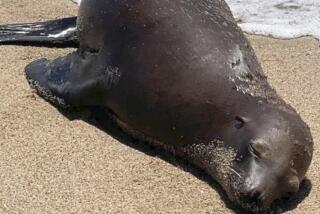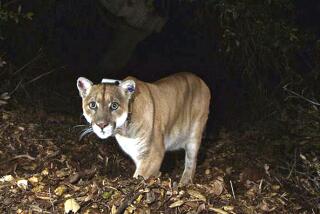Hunter Faces Charges in Condor Death
A Kern County hunter was charged Tuesday with killing a California condor -- one of the last born in the wild -- during a pig hunt earlier this year on Tejon Ranch near Bakersfield.
Britton Cole Lewis, 29, of Tehachapi was charged with violating a federal law protecting migratory birds by allegedly shooting the condor known as AC-8, a matriarch of the federal government’s $35-million program to rescue the endangered bird from extinction. The incident occurred on or about Feb. 8.
Kurt Stiefler, Lewis’ attorney, confirmed the shooting took place during a pig hunt at the ranch, but declined further comment.
Lewis was not charged with violating the U.S. Endangered Species Act, apparently because of a little-known 1998 Justice Department policy that seeks a higher level of proof in such cases, according to a source familiar with the investigation. Essentially a defendant must know the animal was endangered, said the source, who asked for anonymity because it is a pending legal matter.
Assistant U.S. Atty. E. Robert Wright, who is prosecuting the condor case, confirmed that efforts were made to get the solicitor general’s office, which handles significant cases for the Justice Department, to change the policy. He did not elaborate.
If convicted under the federal Migratory Bird Treaty Act, Lewis could face up to six months in prison and a fine of $15,000. A violation of the Endangered Species Act could bring a maximum one-year prison term and a $100,000 fine.
The decision to prosecute Lewis under the lesser charge angered environmentalists as well as those responsible for protecting the bird. Only 79 condors remain in the wild today.
“It’s a slap on his wrist and a slap in our faces,” said Mike Clark, a member of the condor recovery team at the Los Angeles Zoo. “He was poaching, straight up. He’s one of those people that give hunters a bad name.”
Michael Bean, senior attorney with Washington, D.C.-based Environmental Defense, agreed that stronger action was needed. “The California condor is one of the rarest species in the world. The effort to prevent its extinction has been one of the most expensive conservation efforts the United States has undertaken on the part of a species,” Bean said.
“To pursue what amounts to a slap on the hand for killing this bird is outrageous.”
State Resources Secretary Mary Nichols said her office will determine whether there is a need to bring additional charges against Lewis in state court.
“It’s a truly heinous crime that this man is charged with,” Nichols said. “It’s important that the prosecutors send the message that we’re determined to restore these birds to their rightful places in the environment.”
AC-8 was among nine original condors captured in 1986 in a last-ditch effort to save the species from extinction. Weighing at least 20 pounds with a 9-foot wingspan, she spent the next 14 years in the federal government’s captive breeding program.
At 30 years old, the bird had produced a dozen offspring. She was returned to the wild in April 2000 to serve as a mentor for younger, captivity-bred condors released into the wild.
Mark Hall, manager at Hopper Mountain Refuge, found the dead bird on Feb. 13, after entering Tejon Ranch east of the Grapevine. The private ranch, spanning 260,000 acres, is a historic foraging area for condors.*
Times reporters Steve Chawkins and Amanda Covarrubias and Times library researcher Scott Wilson contributed to this report.
More to Read
Sign up for Essential California
The most important California stories and recommendations in your inbox every morning.
You may occasionally receive promotional content from the Los Angeles Times.









